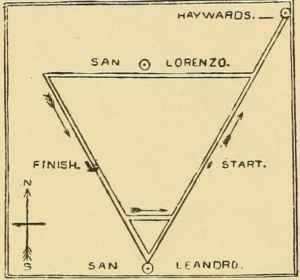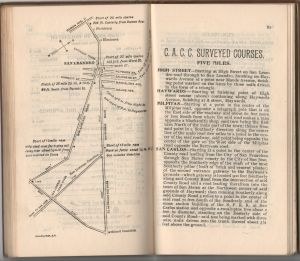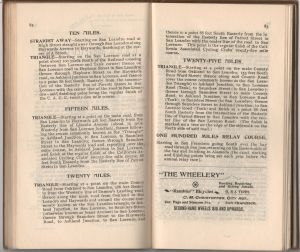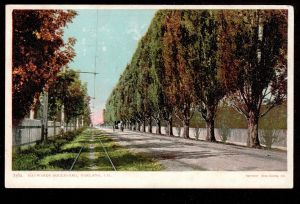Difference between revisions of "San Leandro triangle"
| (2 intermediate revisions by the same user not shown) | |||
| Line 2: | Line 2: | ||
<i>The San Leandro Triangle was a race course frequently used in the late 19th and early 20th centuries by bicycle racers, and later motorcycle and car racers. It used existing roads and landmarks to make a course which, ridden three times, equaled almost exactly 25 miles, a commonly-used unit of distance racing. Below are some original articles, maps, and a summary of the course.</i> | <i>The San Leandro Triangle was a race course frequently used in the late 19th and early 20th centuries by bicycle racers, and later motorcycle and car racers. It used existing roads and landmarks to make a course which, ridden three times, equaled almost exactly 25 miles, a commonly-used unit of distance racing. Below are some original articles, maps, and a summary of the course.</i> | ||
<blockquote> | |||
There will be a fifty-mile race between five members of the [[Bay City Wheelmen]] and five of the [[Highland Club]] boys on February 22d, the course being from Gilroy to Menlo Park. The prize is a club bugle, to be awarded the club whose representative wins the race. Thursday, [[W. J. Bowman]], [[Jerome Churchill]] and [[J. Blinn]], of the Highland Club, were in this section making a fifty-mile road [[run]]. The course is from [[San Leandro]], up the [[Hayward road]], to the Lewelling road, to [[San Lorenzo]]; thence down the San Lorenzo road, via L. Stone, to starting point, a distance of eight and seven-eighths miles. One run, which was timed, was made in 34 minutes. The run will be an exciting one. | |||
</blockquote> | |||
[[A Bicycle Race. - Oakland Tribune, February 20, 1886]] | |||
<blockquote> | <blockquote> | ||
| Line 22: | Line 28: | ||
[[Frank D. Elwell]] made his first appearance as a handicapper, and his work would have been quite good if the scratch men had shared the pacemaking as they should have done. | [[Frank D. Elwell]] made his first appearance as a handicapper, and his work would have been quite good if the scratch men had shared the pacemaking as they should have done. | ||
[[Griffiths]], the winner, is a new man, and diligent inquiry failed to bring to light any performance on which to base a handicap. Consequently he was given the limit of 12 minutes. He is nicely built, and with proper preparation should be heard from again. | [[T. A. Griffiths|Griffiths]], the winner, is a new man, and diligent inquiry failed to bring to light any performance on which to base a handicap. Consequently he was given the limit of 12 minutes. He is nicely built, and with proper preparation should be heard from again. | ||
[[Faulkner]], who established the new record of 1h. 19m. 4s., raced many times on the track last year, and won but one prize, second, in the novice race at San Jose on Thanksgiving Day. He is more of a road than a path rider. | [[Faulkner]], who established the new record of 1h. 19m. 4s., raced many times on the track last year, and won but one prize, second, in the novice race at San Jose on Thanksgiving Day. He is more of a road than a path rider. | ||
| Line 65: | Line 71: | ||
[[File:Screen Shot 2021-09-29 at 8.57.44 AM.png|thumb|center|"A Picturesque Road.<br/>The accompanying photograph gives an excellent idea of a portion of an automobile-haunted California road that runs between San Leandro and Haywards in Alameda county. The road is lined for miles and miles by well-kept orchards, and in many cases these orchards are protected by veritable hedges of tall poplars. The photograph shows a typical row of these picturesque trees, with an orchard on the other side of the fence."<br/>[https://www.google.com/books/edition/The_Automobile/mBE0qNKVzz4C?hl=en&gbpv=1&dq=%22san%20leandro%20-%20haywards%20road%22%20alameda%20county%2C%20california&pg=PA342&printsec=frontcover THE AUTOMOBILE, March 4, 1905]]] | [[File:Screen Shot 2021-09-29 at 8.57.44 AM.png|thumb|center|"A Picturesque Road.<br/>The accompanying photograph gives an excellent idea of a portion of an automobile-haunted California road that runs between San Leandro and Haywards in Alameda county. The road is lined for miles and miles by well-kept orchards, and in many cases these orchards are protected by veritable hedges of tall poplars. The photograph shows a typical row of these picturesque trees, with an orchard on the other side of the fence."<br/>[https://www.google.com/books/edition/The_Automobile/mBE0qNKVzz4C?hl=en&gbpv=1&dq=%22san%20leandro%20-%20haywards%20road%22%20alameda%20county%2C%20california&pg=PA342&printsec=frontcover THE AUTOMOBILE, March 4, 1905]]] | ||
<i>Road names in the 1890s were completely different from now, for the region. Period accounts are inscrutable, for instance, from | <i>Road names in the 1890s were completely different from now, for the region. Period accounts are inscrutable, for instance, from [[THE WHEELMEN. San Francisco Call, 14 August 1897]]:</i> | ||
<blockquote> | <blockquote> | ||
Latest revision as of 19:19, 6 July 2023
The San Leandro Triangle
The San Leandro Triangle was a race course frequently used in the late 19th and early 20th centuries by bicycle racers, and later motorcycle and car racers. It used existing roads and landmarks to make a course which, ridden three times, equaled almost exactly 25 miles, a commonly-used unit of distance racing. Below are some original articles, maps, and a summary of the course.
There will be a fifty-mile race between five members of the Bay City Wheelmen and five of the Highland Club boys on February 22d, the course being from Gilroy to Menlo Park. The prize is a club bugle, to be awarded the club whose representative wins the race. Thursday, W. J. Bowman, Jerome Churchill and J. Blinn, of the Highland Club, were in this section making a fifty-mile road run. The course is from San Leandro, up the Hayward road, to the Lewelling road, to San Lorenzo; thence down the San Lorenzo road, via L. Stone, to starting point, a distance of eight and seven-eighths miles. One run, which was timed, was made in 34 minutes. The run will be an exciting one.
A Bicycle Race. - Oakland Tribune, February 20, 1886
CALIFORNIA'S FAMOUS ROAD.
SOME GOSSIPY COMMENT CONCERNING THE RECENT ROAD RACE OVER THE SAN LEANDRO TRIANGLE.
SAN FRANCISCO, Feb. 24, 1893. — The first great race of the year — the twenty-five mile road race of the California Associated Cycling Clubs — was successfully run off over the San Leandro triangle on February 22.
The Call reporter wrote:
"It was a perfect California Winter day. The gentlest sort of a breeze made the genial sunshine more delightful. The balmy air was perfumed and the green foothills a few miles eastward were the background of the inspiring picture presented by the broad, rich plain filled with orchards and pretty homes. Flowers blazed in every dooryard in town and country, and the apricot orchards were glorious in their myriads of blooms of pinkish white.
Amid such surroundings is found the San Leandro triangle, which is said to be the finest twenty-five mile cycling race course in America. Another advantage of it is that the whole community rather likes to have it put to this use, and is indulgent to the wheelmen. Every farmer will cheerfully turn out to give a racing rider full right of way."
It surely was a perfect day. The weather had been clear for ten days before the race and the roads were in grand condition, although a trifle dusty. The riders generally were well trained.
Frank D. Elwell made his first appearance as a handicapper, and his work would have been quite good if the scratch men had shared the pacemaking as they should have done.
Griffiths, the winner, is a new man, and diligent inquiry failed to bring to light any performance on which to base a handicap. Consequently he was given the limit of 12 minutes. He is nicely built, and with proper preparation should be heard from again.
Faulkner, who established the new record of 1h. 19m. 4s., raced many times on the track last year, and won but one prize, second, in the novice race at San Jose on Thanksgiving Day. He is more of a road than a path rider.
The previous record over this course was 1h. 20m. 25s., made by Grant Bell on November 13, 1892.
WHAT A CHAMPION OWES TO HIMSELF.The great disappointment of the race was the defeat of W. J. Edwards by W. F. Foster. Edwards retired at the end of last season the undisputed champion of the coast. To please some of his friends he started in the road race against his own judgment, and not having time to train properly the result was an easy defeat by a rider who could not approach him last season.
A champion owes it to himself never to race unless properly trained. In the first place the mind still retains its old training while the muscles have entirely relaxed, and the mind may call on the body to do more than it can perform, which may result in permanent injury. Again, the public at large do not take into consideration a man's condition, but simply see that he was beaten, and the latest winner basks in the sunshine of public favor.
D. L. Burke said recently that he would not come up here to race Edwards, and now he really has no reason to do so. He has beaten Foster easily, and Foster has beaten Edwards easily (apparently).
Edwards was at one time a racing protege of mine, and I feel keenly his defeat and the lack of judgment displayed in making him ride when he had so much to lose and nothing to gain by so doing.
This was the sixth twenty-five mile race contested on this course.
The first was held February 22, 1888, under the auspices of the Oakland Ramblers, and was won by F. D. Elwell in 1h. 33m. 56s.
The second was arranged by the California Road Racing Association, and was won by Elwell in 1h. 38m.
The third was also arranged by this Association, and was won by the invincible, all-conquering Elwell in 1h. 37m. 2 2-53.
On May 30, 1891, the Alameda Bicycle Club promoted a most successful open race, which was won by Frank Waller in 1h. 24m. 57s.
On November 6, 1892, the Bay City Wheelmen held a club race that was won by W. F. Foster in 1h. 21m. 33s.
On November 13 Grant Bell won the Acme Athletic Club race in 1h. 20m. 25s.
CALIFORNIA.
"Amid such surroundings is found the San Leandro triangle, which is said to be the finest twenty-five mile cycling race course in America. Another advantage of it is that the whole community rather likes to have it put to this use, and is indulgent to the wheelmen. Every farmer will cheerfully turn out to give a racing rider full right of way."
There are many mentions of the San Leandro Triangle" in media. There are 161 results for it in the California Digital Newspaper Collection, 392 results at newspapers.com and google returns 477. It was a common course. It was relatively flat - these bikes had no gears, and the racers were really fascinated with speed and distance records - and because it was pretty country at the time, and it was accessible from rail (Fruitvale Station in Oakland, near the current BART Fruitvale Station) and boat near the city of Oakland. The route to it, on the "San Leandro Road", AKA the "Haywards Road" was scenic and a nice spin for spectators. Later, motorcycle and car races were run over the course.
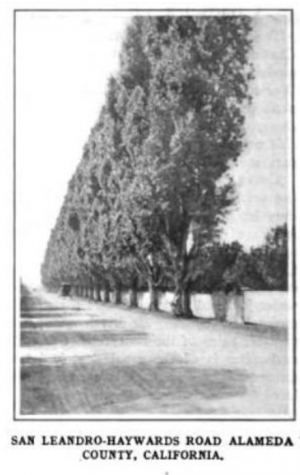
The accompanying photograph gives an excellent idea of a portion of an automobile-haunted California road that runs between San Leandro and Haywards in Alameda county. The road is lined for miles and miles by well-kept orchards, and in many cases these orchards are protected by veritable hedges of tall poplars. The photograph shows a typical row of these picturesque trees, with an orchard on the other side of the fence."
THE AUTOMOBILE, March 4, 1905
Road names in the 1890s were completely different from now, for the region. Period accounts are inscrutable, for instance, from THE WHEELMEN. San Francisco Call, 14 August 1897:
The course ... to the power-house this side of San Leandro .... to the first junction - beyond San Leandro ... to the first turn. From Haywards to San Lorenzo ... to the tank corner ... across the railroad track ... back into San Leandro.
Here is a course description, with maps:
The route information below relies on these two maps:
- Official map of Alameda County, California, 1900, georeferenced here
- Map of Oakland and vicinity, Showing Real Estate & Electric Railways
Here is the 25-mile course, from the above book:
TWENTY-FIVE MILES.
TRIANGLE - Starting at a point on the main County Road from Oakland to San Leandro, 153 feet South from Ward Street; thence along said County Road (over the course commonly known as the San Leandro Triangle) to Ashland Junction, to San Lorenzo Road (Tank), to Saunders Street (in San Leandro): thence through Saunders Street to main County Road, to Ashland Junction, to San Lorenzo Road (Tank), to Saunders Street (in San Leandro); thence through Saunders Street to Ashland Junction, to San Lorenzo Road (Tank) and finish at a point 88 feet South Easterly from the intersection of the Easterly line of Parrott Street in San Leandro with the center line of the San Lorenzo Road, (The finish is marked on a tree on the edge of the sidewalk on the North side of said road.)
San Leandro street names had changed:
Ward St. became West Estudillo Ave.
Saunders St. became West Juana Ave.
It becomes apparent that:
County Road from Oakland to San Leandro = International Blvd / East 14th St. / Mission Blvd
Ashland Junction = East 14th & East Lewelling Blvd
San Lorenzo Road = Washington Ave.
Note that there is a road-cut to soften the corner at "Ashland Junction" (Mission Bvd & E. Lewelling Blvd). They didn't have it, so go past that to the actual intersection and make the more acute turn, if you want to ride the course as they did. East 14th St changes its name to Mission Blvd after it goes under highway 238, southbound. It would have been called "Haywards Road" back then.
It appears that Tank Corner is now Washington Ave & Lewelling Blvd:
A lease for ten years from J. B. Marlin to the County of Alameda of a piece of ground for a windmill, tank, etc., in the San Lorenzo Road District, was, on motion of Mr. Dusterberry, accepted.
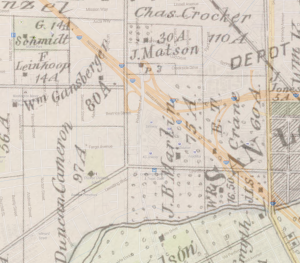
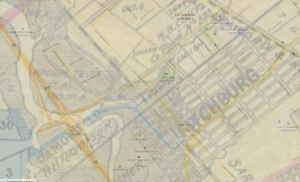
In the 1880s and 1890s, when 'cyclers' were first riding and racing on these roads, the other traffic was horse-drawn, horses and pedestrians. Some sections are not as bike friendly as they once were. It's an industrial / urban neighborhood now. A local rider, Jason Hammon writes: "East 14th is not bike friendly through downtown San Leandro, but it opens up after about a half mile. Washington has a stretch just before San Leandro Blvd that might pose a problem too, because it goes under the train tracks and has no shoulder."
Three articles which mention the San Leandro Triangle:
- The San Francisco Call, 25 Aug 1890, Mon, Page 7 - WHEELMEN’S WHIRLS - Entries for the Twenty-five-mile Race. Trip to Tamalpais.
- AMONG THE WHEELMEN - San Francisco Chronicle 15 Jun 1895
- THE WHEELMEN. San Francisco Call, 14 August 1897
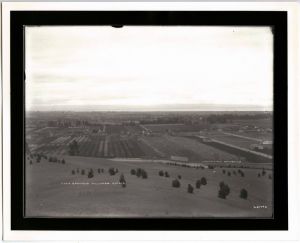
This was the end of racing on the Triangle:
NO MORE CYCLE RACES.
TRUSTEES OF SAN LEANDRO PASS ORDINANCE TO THAT EFFECT.
SAN LEANDRO, August 18. - At the last meeting of the Board of Trustees of this city an ordinance was passed regulating the speed of automobiles, auto cycles, bicycles, etc., to eight miles per hour within the city limits. This prohibits cycle racing on the famous triangle and on this account considerable heated discussion was indulged in before the passing of the ordinance. An amendment was introduced allowing bicycle racing, but was voted down and the ordinance was passed as originally proposed.
Trustee Barberio opposed the measure, claiming that the revenue of the town would be considerably lessened thereby. For many years wheelmen have made their headquarters here and some of the best races that have been ridden in California have taken place on the San Leandro triangle. On Sundays, during the racing season, hundreds of cyclists were wont to congregate in the town. As a result of the ordinance, Trustee Barberio claimed all this would be stopped.
Pages which link here:
- Oakland Bicycle Club (← links)
- The Wheelmen - The San Francisco Call, 25 May 1895 (← links)
- File:San Leandro triangle, with 25-mile start.jpg (← links)
- Walter F. Foster (← links)
- Oakland Young Men's Christian Association Cycling Club (← links)
- Harry Austin Goddard (← links)
- The Wheel. - San Francisco Chronicle, 17 Nov 1886 (← links)
- The Wheelmen. - San Francisco Chronicle, 27 Apr 1891 (← links)
- Alex J. Rosborough (← links)
- CHAT ABOUT THE CYCLE. - A Brief Sketch of the Capitol City Wheelmen. - The San Francisco Call, Aug 22, 1892 (← links)
- RACING WHEELMEN. - Oakland Tribune, 22 Feb 1888 (← links)
- THE WHEELMEN. - Oakland Tribune, 08 Nov 1886 (← links)
- BICYCLING. - Oakland Tribune, 22 Nov 1886 (← links)
- Oakland Ramblers (← links)
- 'CYCLING AT SAN LEANDRO. - Daily Alta California, Volume 41, Number 13602, 26 November 1886 (← links)
- The Wheelmen. - San Francisco Chronicle, 26 May 1890 (← links)
- HIS RACING CAREER - Walter Foster Gets Favorable Mention. - Alameda Daily Argus, 19 Oct 1895 (← links)
- The Wheelmen. - San Francisco Chronicle, 01 Jun 1891 (← links)
- CHAT ABOUT THE CYCLE - Grant Bell Wins the Road Race of the Acme Club. - Preparations for the Thanksgiving Day - Events at San Jose - Close of the League Campaign. - The San Francisco Call, 14 Nov 1892 (← links)
- THE WHEELMEN. - Election of Officers of the Ariel Bicycle Club. - Oakland Tribune, 01 Feb 1888 (← links)
- CYCLING UP TO DATE. - Farewell Banquet Tendered Wilbur J. Edwards at San Jose. - The San Francisco Examiner, 27 Jun 1894 (← links)
- OLYMPIC CYCLISTS. Young Men Who Will Boom Wheeling. Some Reminiscences of the Sport. - Sat, Oct 14, 1893 - Page 10 - San Francisco Chronicle (← links)
- THE WHEELMEN. - The San Francisco Call, 06 Jul 1895 (← links)
- AMONG THE WHEELMEN. - A Cycling Trip to Santa Cruz - San Francisco Chronicle, 29 Jun 1895 (← links)
- AMONG THE WHEELMEN - San Francisco Chronicle 15 Jun 1895 (← links)
- AMONG THE WHEELMEN - San Francisco Chronicle, 22 Jun 1895 (← links)
- CHAT ABOUT THE CYCLE. - Organization and Growth of the Pacific Road Club. - The San Francisco Call, 27 Jun 1892 (← links)
- Pacific Road Club (← links)
- San Lorenzo triangle (redirect page) (← links)
- THE WHEELMEN. - The San Francisco Call, 31 Aug 1895 (← links)
- TO OLYMPUS ON WHEELS. - Annual Feast and Games of the O. C. Cyclers at Escalles. - San Francisco Chronicle, 14 May 1898 (← links)
- BYRNE BADLY BRUISED - An Accident During the Acme Road Race. - The San Francisco Call, 11 Feb 1895 (← links)
- Members of Acme Athletic Club Hold Fourth Reunion - Oakland Tribune, 06 May 1924 (← links)
- WHEELMEN TO BE PUNISHED. - San Francisco Chronicle, 07 Jul 1896 (← links)
- The Wheelmen. - San Francisco Chronicle, 25 May 1891 (← links)
- The Bicycle Sports. - The San Francisco Examiner, 22 Nov 1886 (← links)
- IMPERIAL ROAD RACE. - FRANK BYRNE THE WINNER. - The San Francisco Call, 04 Feb 1895 (← links)
- Foster Breaks the Bicycle Record. - San Francisco Chronicle, 31 May 1891 (← links)
- WITH THE WHEELMEN. - San Francisco Chronicle, 08 Jun 1895 (← links)
- THE WHEELMEN. - J. E. Edwards Wants the World's Five-Mile Road Record. - The San Francisco Call, 18 May 1895 (← links)
- A Bicycle Race. - Oakland Tribune, February 20, 1886 (← links)
- WHEELMEN PREPARED FOR BIG ROAD RACE - The San Francisco Examiner, April 27, 1902 (← links)
- San Leandro-Haywards course (← links)
- THE CYCLING WORLD - OLD TIME RACING MEN. - San Francisco Chronicle, Sat, Jul 8, 1893 (← links)
- READY FOR THE BIG ROAD RACE - The San Francisco Call - Jun 8, 1901 (← links)
- Haywards triangle (redirect page) (← links)
- CYCLERS WILL RACE AT THE GARDEN CITY - The San Francisco Call - March 04, 1899 (← links)
- Lowell High School (← links)
- Charles A. Kraft (← links)
- THE WHEELMEN. San Francisco Call, 14 August 1897 (← links)
